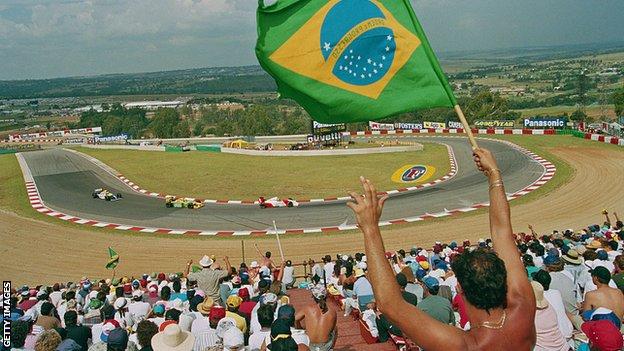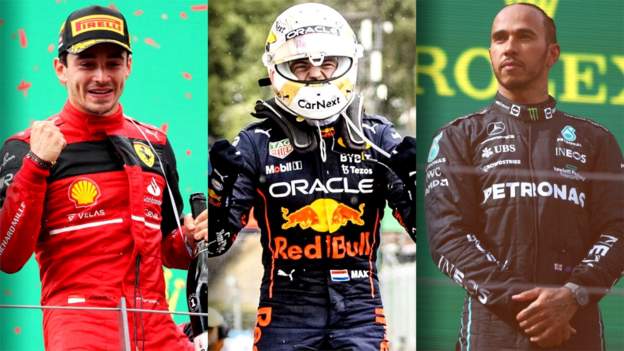
Formula 1 reconvenes at the Belgian Grand Prix this weekend – the end of its summer break marking the start of a hectic run of nine races in 12 weeks that will decide the 2022 World Championship, and much more besides.
Red Bull’s Max Verstappen appears to be heading inexorably towards a second world title, helped on his way by Ferrari’s propensity for shooting themselves in the foot.
Lewis Hamilton is in danger of losing his record of winning a race in every season of his career – but could a rule change that comes into force this weekend help him maintain it?
And the 2023 driver market still needs to be resolved after Fernando Alonso’s move to Aston Martin sparked a manic couple of days following the last race in Hungary.
The title fight
Verstappen heads into what are effectively two home races on consecutive weekends in Belgium and the Netherlands with an impregnable-looking 80-point lead over his only realistic rival – Ferrari’s Charles Leclerc.
It shouldn’t be this way. Red Bull and Ferrari are incredibly closely matched, but while Ferrari have managed to turn seven Leclerc pole positions into only three victories, Verstappen’s record is an almost exact inverse – eight wins from just three poles.
To put the Dutchman’s lead into context, Leclerc could win all the remaining races and claim the fastest lap bonus points and still not win the title if Verstappen is second in each one.

Things can turn around quickly, as Leclerc has discovered to his dismay. He had a 46-point lead after only three races this season. Three races later, Verstappen was in front, from where he has moved steadily forward, with just the odd blip, ever since.
Ferrari are showing no signs of being able to engineer such a recovery.
Leclerc has lost potentially winning positions five times in 12 races – twice to an engine failure while leading; three times to strategic errors by the team.
On top of that, Leclerc has made two significant errors, including crashing out of the lead in France.
In the context of that performance, team principal Mattia Binotto’s claim after Hungary – the most recent occasion the team cost Leclerc a win with a questionable strategy – that there was “nothing to change” raised eyebrows. Clearly Ferrari do need to find a way to stop snatching defeat from the jaws of victory.
Leclerc admitted in an exclusive BBC Sport interview earlier this month that the title looks “more and more difficult” but added: “Until it’s mathematically over, then I still want to believe in it.” What else can he say?
The reality is Leclerc needs a turnaround of historically unprecedented proportions if he is to prevail. And unless Ferrari can find a way to immediately start consistently delivering on their potential, Verstappen will clinch the title long before the end of the season.
Will the Mercedes upturn gather pace?
Mercedes have had a difficult start to the season – their least competitive for 12 years. But the first part of the year ended on a high with their first 2022 pole position – secured by George Russell, Hamilton’s best result yet – second place, and the team’s first double podium.
Mercedes have made significant progress with the car in recent weeks, and are optimistic they can continue to do so, and inch closer to Ferrari and Red Bull on pace.
A rule change for this weekend gives them further hope too.
Belgium marks the start of governing body the FIA’s attempt to control ‘porpoising’ – the buzzword of 2022 so far.
This and the related phenomenon of ‘bouncing’ are directly related to the new technical rules introduced this season with the aim of improving the racing.
These make it advantageous to run the cars as close to the ground as possible, which can set up an aerodynamic disruption that leads to the car developing a violent vertical oscillation (porpoising), and makes them prone to smashing into the track over bumps (bouncing).
Back in June, the drivers collectively asked the FIA to take action, fearing there was a long-term risk to their health.

Two key changes have been introduced before Belgium – a vertical oscillation metric, which defines the maximum permitted amount of bouncing; and stricter tests on floor rigidity.
It is the latter that has the most potentially intriguing effect.
The FIA has introduced a new test on the underbody ‘plank’ – a piece of hardwood that can wear only so much and which therefore prevents the ride-height from being run too low. The idea is to prevent the plank from bending upwards into a gap that had been deliberately left by some teams between the plank and underside of the monocoque for that purpose.
Ferrari and Red Bull are two of the teams understood to have been using this design, which is believed to be effective in controlling porpoising. The Mercedes does not have such a gap.
Will this affect the competitive order, and allow Mercedes to close up relative to Ferrari and Red Bull, independent of whatever upgrades each team introduces? Mercedes certainly believe so.
The driver market
Alonso shook up the driver market when he decided over the course of the Hungarian Grand Prix weekend, following Sebastian Vettel’s retirement announcement, that he would move from Alpine to Aston Martin in 2023.
The two-time champion had previously said his first option was to stay at Alpine. But he and the team had reached an impasse on contract length. Alonso wanted two years minimum; they wanted to commit for only one, with an option for more as long as he continued to perform at a high level.
Alpine were intending, were Alonso not to accept their offer, to promote their reserve driver Oscar Piastri – the reigning Formula 2 champion.
But Alpine have been made to pay for their prevarication.
Not only have they lost Alonso, but it soon emerged they had also lost Piastri. On an extraordinary day, 24 hours after the Alonso announcement, Alpine announced they had signed Piastri, only for the Australian to say on Twitter that they hadn’t.
It is clear that Piastri has signed for McLaren, who now have to find a way to extricate Daniel Ricciardo from his 2023 contract to make way for him.
At some point, then, it is assumed that McLaren will announce Piastri will join them for 2023 alongside Lando Norris. But what will Alpine do?
Will they take Ricciardo? They don’t seem to have much option. But will Ricciardo want to go back to the team he left to join McLaren for 2021?
Elsewhere, the future of Mick Schumacher, currently at Haas, is up in the air. His two years in F1 so far have not been especially convincing, bar one or two high points. But might he be an option for Alpine?
The top three teams’ driver line-ups are already confirmed for 2023.
It seems McLaren’s drivers will be Norris and Piastri. Aston Martin will have Alonso and Lance Stroll.
Beyond them and Alpine, Valtteri Bottas and Zhou Guanyu will stay at Alfa Romeo. Kevin Magnussen is confirmed at Haas but does not yet have a team-mate, and nor does Alex Albon at Williams, where F2 frontrunner Logan Sergeant is a contender to replace Nicholas Latifi. Pierre Gasly is confirmed at Alpha Tauri, but will Yuki Tsunoda stay alongside him? Probably, given his Honda links.
There is a lot to sort out.
Audi and Porsche news expected
There are a couple of seismic announcements coming in another area, too.
Following the confirmation of the 2023 engine rules, the entries of Porsche and Audi in 2026 are expected to be announced imminently; Porsche as engine partner to Red Bull and Audi taking over Sauber (currently racing as Alfa Romeo).
To have two such iconic global brands in F1 – Audi for the first time; Porsche returning for a fourth bite – is a huge boost for the championship, especially as they have been attracted back on the basis of the environmental and marketing aspects of the new engine rules.
The 2023 calendar

Next season’s calendar is expected to be announced in late September or early October, and it will have a new look – but how new remains to be seen, as F1 president Stefano Domenicali still has plenty of balls in the air.
A headline new race in Las Vegas – to be held some time in November – has already been confirmed. And France will disappear.
Now, the key questions revolve around the potential for a return to South Africa.
Negotiations with the Kyalami circuit, which last held a race in 1993 but has been modified since, have been ongoing for some time.
The future of the Belgian Grand Prix has been looking shaky for a while, with talk of it starting to alternate with another races. And it had been considered that much-loved Spa’s place in 2023 could depend on whether a deal could be struck in South Africa.
But it seems for now that there is a high chance Belgium will return, at least for next year.
There is also uncertainty around the return of China, which has not held a race since 2019 because of Covid restrictions in the country.
For now, China is expected to be on the calendar, with a new date of October to give the country’s vaccination programme time to progress.
Qatar will return following a year’s hiatus for the football World Cup, and most likely on the Losail circuit rather than the street track in Doha that had been initially planned when the country’s new deal was announced back in 2021.
The season is expected to start in Bahrain, with Saudi Arabia following and then Australia on the already announced date of 2 April, before Qatar and South Africa – if it happens – in April, along with Imola.
Attempts to twin Miami and Canada look to have failed for now, so the new Florida race will continue in its early May slot, before a return to Europe with Spain and Monaco, and back to North America for Montreal in its traditional June date.
After that, things will look much as they do this year, with the addition of Shanghai and Las Vegas.


